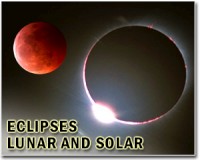 |
Science@NASA Huntsville AL (SPX) Jul 12, 2010 It's every vacationer's dream: You stretch out on a white sandy beach for a luxurious nap under the South Pacific sun. The caw of distant gulls wafts across the warm sea breeze while palm fronds rustle gently overhead. You take it all in through half-closed eyes. Could Paradise get any better? This weekend it will. On Sunday, July 11th, the new Moon will pass directly in front of the sun, producing a total eclipse over the South Pacific. The path of totality stretches across more than a thousand miles of ocean, making landfall in the Cook Islands, Easter Island, a number of French Polynesian atolls, and the southern tip of South America. "It's going to be a beautiful sight," says Lika Guhathakurta of NASA's Heliophysics Division in Washington DC. She herself has witnessed more than eight solar eclipses in a variety of environments from busy cities to lonely deserts to remote mountain peaks. "The South Pacific eclipse could top them all." She imagines how the event will unfold: First, the Moon's cool shadow will sweep across the landscape, bringing a breeze of its own to compete with the sea's. Attentive observers might notice shadow bands (a well-known but mysterious corrugation of the Moon's outermost shadow) rippling across the beach as the temperature and direction of the wind shift. The ensuing darkness will have an alien quality, not as black as genuine night, but dark enough to convince seabirds to fly to their island roosts. As their cries subside, the sounds of night creatures come to the fore, a noontime symphony of crickets and frogs. Next comes the moment that obsesses eclipse chasers: The corona pops into view. When the Moon is dead-center in front of the sun, mesmerizing tendrils of gas spread across the sky. It is the sun's outer atmosphere on full display to the human eye. "You can only see this while you are standing inside the shadow of the Moon," says Guhathakurta. "It is a rare and special experience." Because the sun's atmosphere is constantly shape-shifting, every total eclipse is unique. Predicting what any given one will look like can be tricky. Nevertheless, Guhathakurta is making a prediction. It's based on a new development in solar physics. For the first time, NASA has two spacecraft stationed on opposite sides of the sun. "STEREO-A and STEREO-B are giving us a realtime 3D view of the solar corona, something we've never had before," she explains. "This helps forecast the appearance of the corona during an eclipse." Inspecting images from STEREO and also from the Solar and Heliospheric Observatory (SOHO), she predicts observers could see four ghostly-white streamers, two on either side of the sun. They will stretch out two to three degrees, forming a gossamer "X" in the sky with a black hole at the crossing point. "I'm prepared to be wrong," she confesses. "This is the first time anyone has tried to make such a forecast using STEREO data. It will be interesting to see if it works."
Share This Article With Planet Earth
Related Links NASA's eclipse home page Solar and Lunar Eclipses at Skynightly
 Remote Easter Island braces for total solar eclipse
Remote Easter Island braces for total solar eclipseHanga Roa, Chile (AFP) July 11, 2010 Tourists and scientists poured onto remote and mysterious Easter Island Sunday to watch a rare total eclipse of the sun, a mixed blessing for the Pacific community. An estimated 4,000 tourists, scientists, photographers, filmmakers and journalists flocked to the remote Chilean outpost of only 160 square kilometers (60 square miles), doubling the population of the barren island that already s ... read more |
|
| The content herein, unless otherwise known to be public domain, are Copyright 1995-2010 - SpaceDaily. AFP and UPI Wire Stories are copyright Agence France-Presse and United Press International. ESA Portal Reports are copyright European Space Agency. All NASA sourced material is public domain. Additional copyrights may apply in whole or part to other bona fide parties. Advertising does not imply endorsement,agreement or approval of any opinions, statements or information provided by SpaceDaily on any Web page published or hosted by SpaceDaily. Privacy Statement |